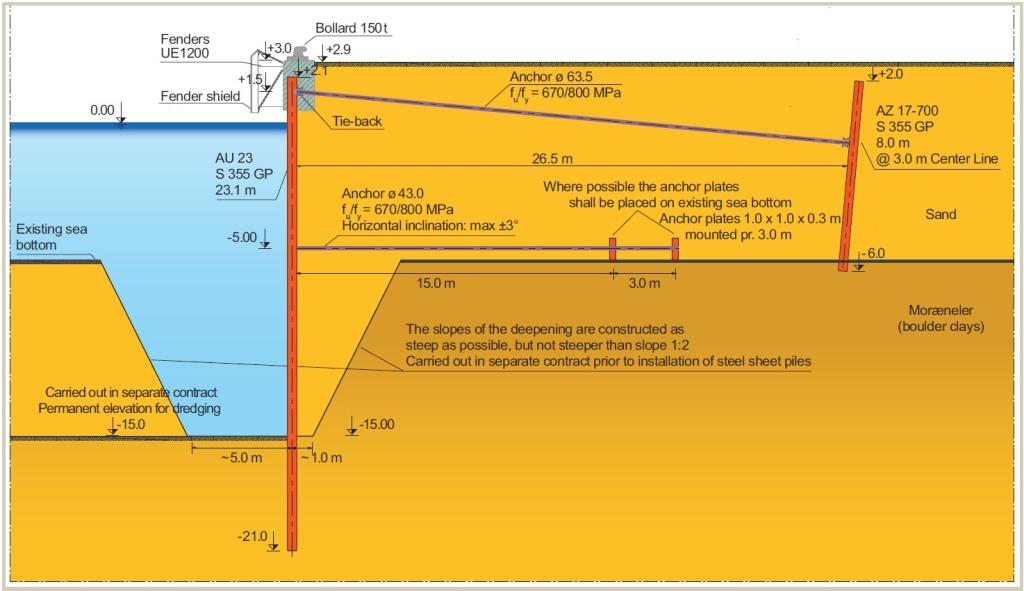
Water Transport Solutions
Port of Kalundborg, DK | 2016
Based on the port’s vision and the demand from the users of the port, Kalundborg port commenced the development of the new container terminal. The development started with a so-called VVM Inspection / Environmental Impact Assessment in 2007, but the design itself began only in 2016, followed by the archaeological investigation. Tender took place in 2017, and the job started in October 2017 by the company Hercules Fundering.
Download the full case study
The project consists of 330 000 m2 multi-terminal with a 500 m long quay with 15 m water depth. This is the deepest water level in an industrial port on Zealand. Mean tide variation is 0.4 m, but a NW storm can lead to a mean high water of up to 1.3 m.
The design is quite atypical: the AU 23 sheet pile, in steel grade S355GP, ranging from 19.1 to 24.1 m in length, is anchored at two levels.
The upper anchor is battered, has a diameter of 63.5 mm, a yield strength of 670 MPa, and is fixed to anchor piles executed with isolated double piles AZ 17-700 and AZ 19-700 sheet piles, in S355GP, ranging from 8.0 to 9.0 m in length.
The second level of anchors is horizontal and lies 5.0 to 6.0 m below the water level, each anchor having a diameter of 43.0 mm and a yield strength of 670 MPa. These anchors are shorter, and are fixed to a concrete panel of dimensions 1.0*1.0*0.3 m.
The AZ anchor piles are located at a distance of around 27.0 m from the main wall, whereas the concrete panels are located at a distance of about 15.0 m, respectively 18.0 m (alternating along the wall: one short, one long).
The soil is composed of a rather soft layer of sediments (gytje, an organic deposit/ mud, respectively sand), followed by a firm to stiff layer of moræneler (boulder clays).
The consulting engineering firm Niras made the design and the tender documents, and was also in charge of the management of the construction and its supervision.
Hercules Fundering installed the steel sheet piles and anchors, whereas the backfilling was performed by Rhode Nielsen and NCC Industry, pumping around 15 000 m3 per day of sand into the new terminal (approximately of 1 million m3).

The Finnish dredging company Wasa Dredging dredged some 900 000 m3 material from the bottom of the sea to secure the 15 m water depth.
The driving of the sheet piles was performed with an hydraulic impact hammer Junttan SHK 110 – 9t (max. energy of 119 kNm, max drop height of 1.2 m, blows per minute between 52 and 120), fixed on a Junttan PMx27 telescopic piling rig. The installation took place from a jack-up barge, and the speed of installation was quite impressive: 10 to 25 double piles daily.
The port is expected to start operating in March 2019.
